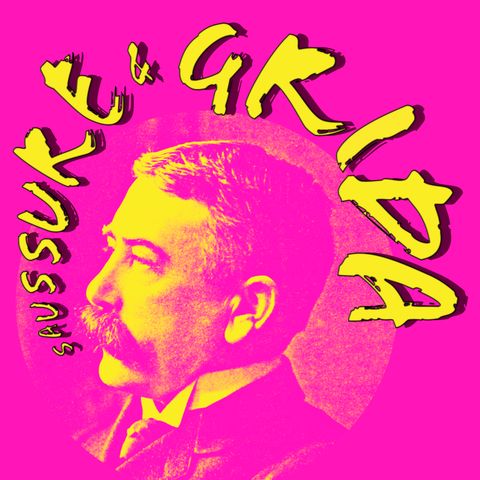3. Come parliamo ai neonati, ovvero il "baby talk"

Download and listen anywhere
Download your favorite episodes and enjoy them, wherever you are! Sign up or log in now to access offline listening.
May 16, 2023 ·
13m 43s
Come parlate quando avete un neonato o una neonata in braccio? Se fate delle vocette acute e imbarazzanti siete in buona compagnia con la quasi totalità degli esseri umani. In...
show more
Come parlate quando avete un neonato o una neonata in braccio? Se fate delle vocette acute e imbarazzanti siete in buona compagnia con la quasi totalità degli esseri umani. In questa puntata parliamo del "baby talk" e di che cos’è, e proviamo a vedere perché lo usiamo e perché piace tanto ai cuccioli di homo sapiens.
L'audio del baby talk preso dal canale Youtube di https://reachoutandread.org/
La sigla è stata prodotta da White Hot e fornita da https://freebeats.io
Grafiche: Gianluca La Bruna
FONTI:
show less
L'audio del baby talk preso dal canale Youtube di https://reachoutandread.org/
La sigla è stata prodotta da White Hot e fornita da https://freebeats.io
Grafiche: Gianluca La Bruna
FONTI:
- Albin, D.D., & Echols, C.H. (1996). Stressed and word-final syllables in infant-directed speech. Infant Behavior & Development, 19(4):401–418.
- Ben-Aderet T., Gallego-Abenza M., Reby D., & Mathevon N. (2017). Dog-directed speech: why do we use it and do dogs pay attention to it? Proceedings of the Royal Society B284(1846)
- DeCasper A.J., Lecanuet J.P., Busnel M.C., Granier-Deferre C., & Maugeais R. (1994). Fetal reactions to recurrent maternal speech. Infant Behaviour and Development, 17(2):159-164.
- Dissanayake, E. (2000). Antecedents of the Temporal Arts in Early Mother-Infant Interaction. In N. Wallin, B. Merker, and S. Brown (Eds.) The Origins of Music:389-410. Cambridge: MIT Press.
- Eimas P.D., Siqueland E.R., Jusczyk P., & Vigorito J. (1971). Speech perception in infants. Science 171:303-306.
- Eimas, P.D., & Quinn, P.C. (1994). Studies on the formation of perceptually based basic-level categories in young infants. Child Development, 65:903–917.
- Fernald, A. (1985). Four-month-old infants prefer to listen to motherese. Infant Behaviour and Development, 8:181-195.
- Fernald, A., & Mazzie, C. (1991). Prosody and focus in speech to infants and adults. Developmental Psychology, 27:209–221.
- Fernald, A., & Simon, T. (1984). Expanded intonation contours in mothers’ speech to newborns. Developmental Psychology, 20:104–113.
- Green, J.R., Nip, I.S.B.; Wilson, E.M.; Mefferd, A.S.; Yunusova, Y.(2010). Lip Movement Exaggerations During Infant-Directed Speech. Journal of Speech, Language, and Hearing Research. 53(6):1529–1542.
- Jusczyk P.W., Cutler A., & Redanz N. (1993). Preference for the predominant stress patterns of English words. Child Development, 64:675-687.
- Kuhl P.K. (1991). Human adults and human infants show a "perceptual magnet effect" for the prototypes of speech categories, monkeys do not. Perception & Psychophysics, 50(2):93-107.
- Lacerda, F., Klintfors, E., Gustavsson, L., Lagerkvist, L. Marklund, E. & Sundberg, U. (2004) “Ecological Theory of Language Acquisition.” In. Berthouse, L., Kozima, H., Prince, C., Sandini, G., Stojanov, G., Metta G & Balkenius, C. (Eds.) Proceedings of the Fourth International Workshop on Epigenetic Robotics (EPIROB 2004) Lund University Cognitive Studies, 117:147-148.
- Mithen, S. (2006) The Singing Neanderthals: The Origins of Music, Language, Mind and Body. London: Weidenfeld and Nicolson.
- Patel, A. (2008). Music, Language, and the Brain. Oxford: Oxford University Press.
- Trainor, L.J., Tsang, C.D., & Cheung, V.H.W. (2002). Preference for Sensory Consonance in 2- and 4-Month-Old Infants. Music Perception: An Interdisciplinary Journal, 20(2):187-194.
- Vosoughi, S., & Roy, D. (2012) A longitudinal study of prosodic exaggeration in child-directed speech. Proceedings in Speech Prosody:194-197
Information
| Author | Irene |
| Website | - |
| Tags |
Copyright 2024 - Spreaker Inc. an iHeartMedia Company
